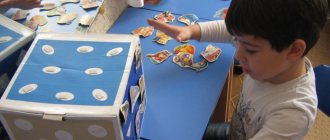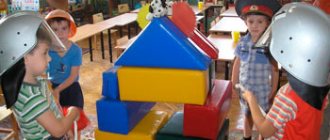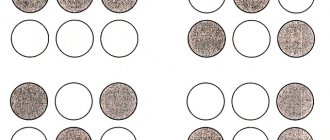Fairy tale therapy: theory and practical application
How does fairy tale therapy work?
Fairytale therapy is designed to help a child concentrate on a certain problem, show ways to solve it, without giving strict recommendations. In each story, a certain situation that arose in the life of a child is played out, the characters in the story have the characteristics of real people, and the conflict that arises always has a logical resolution. Fairytale therapy establishes connections between fairy-tale events and behavior in real life, transfers bookish, magical meanings into reality. The main principle of the method is the spiritual, holistic development of the child’s personality, caring for his soul.
A fairy tale not only teaches, but also heals.
Fairytale therapy helps children who have lost their parents. The child meets himself in a fairy tale, with a good, best expression of himself. Learns from himself fabulous good deeds, learns to be happy.
Fairytale therapy in kindergarten and at home
Collective writing of fairy tales is very useful. For young children, this is an exercise in interaction; for teenagers, it is a way to understand themselves and their peers. Using the example of a jointly created fairy tale, you can understand who plays what roles in the team.
It is useful for parents to compose together with their child, because at such moments you begin to speak in a common language and can find out the child’s hidden thoughts and desires. By hiding them behind symbols and metaphors, the young storyteller frees himself internally, and a caring and attentive parent can unravel the desires and subconscious aspirations of the child.
The fairy tale stimulates creative thinking and develops a sense of humor in parents and children. And by depicting magical characters on paper or plasticine, the child practices modeling, writing and drawing skills, develops perseverance and attentiveness.
What kind of fairy tales are there?
All fairy tales can be divided into four groups according to the problems they raise:
- Difficulties in communication.
The fairy tale plays out conflicts, grievances, and disagreements that arise in a child in the yard, at school, in kindergarten, and within the family circle.
- Inner experiences.
The effect of a magic mirror arises, which allows you to carefully examine your as yet unknown inner world, level out emerging contradictions and complexes, and answer the question “what’s wrong with me?”
- Fears.
It is important for parents to know what their child is afraid of and, most importantly,
how he is afraid of it
. If fear slows down development, takes away emotional strength, and becomes an insurmountable obstacle to personal growth, then the child needs help. - Age-related difficulties.
Each age has its own critical moments associated with the child’s awareness of his new role. For example, accepting oneself as an independent person in preschool age, or problems related to learning in primary school age. All this can be said through a fairy tale.
Types of fairy tales in fairytale therapy:
- Artistic tales.
The plots that are closest to ordinary folklore are universal and are rarely adapted to a specific child. They are mainly used as maintenance therapy and are not used to correct more serious problems. The main principle of artistic fairy tales is “do no harm.”
- Psychocorrectional tales.
They imply a gentle correction of certain character traits and behavior. Often used for children with hyperactivity and aggressive manifestations. These tales must be studied individually by a psychologist.
- Psychotherapeutic tales.
They are used when working with children from 3 to 8 years old after a superficial study of the child’s problems. It is psychotherapeutic fairy tales that are the main tool for correcting fears and phobias.
There are also universal psychotherapeutic fairy tales that can be used without adaptation by a psychologist to a specific child. In this case, the factor that increases the effectiveness of the fairy tale is personalization: the main character of the fairy tale is the child himself. Usually, ready-made collections of therapeutic tales are used on the most common problems (fear of the dark, greed, etc.).
- Meditative tales.
They are distinguished by the absence of conflicts and evil heroes. They are designed for relaxation after psychological stress. They are the most difficult type in fairy tale therapy because they are not aimed at solving a specific problem. Meditative fairy tales are often told in the format of a dialogue with a child, which helps the psychologist-storyteller change the plot based on the child’s obvious or hidden needs.
- Didactic fairy tales.
Often used for preschoolers and children of primary school age. Their purpose is to teach the child something new in an interactive way. Used in primary schools as part of the curriculum. With the help of such a fairy tale, you can work with your child on this or that situation, behavior pattern, and system for finding a solution.
For children and adults
Fairytale therapy is used in kindergartens, schools and rehabilitation centers. Based on fairy tale therapy, collections of therapeutic personalized fairy tales are created. Fairy tales are used to treat various fears in children, excessive aggressiveness, laziness, hyperactivity, reluctance to go to kindergarten, nervous tics, fears, enuresis and anorexia.
Fairytale therapy resolves conflicts with parents, eliminates communication difficulties, learning difficulties, aggressiveness in relationships, feelings of inferiority, loneliness, and self-doubt.
But fairy tale therapy is useful not only for children. Remember your favorite magical story from childhood, tell it to yourself, smile, close your eyes, relax... Do you feel it? This is how fairytale therapy works. It’s not for nothing that fairytale therapists advise carrying a pocket book with your favorite fairy tale. After all, how good it is to read a good, time-tested fairy tale after a hard day at work. Even if it’s “Kolobok”.
“What is this fairy tale about?” you ask. It teaches that everyone has a purpose in this world and shows what can happen when we give up our path.
In all fairy tales, the dialectic of the world is visible: without evil there cannot be good, and vice versa. This teaches a very important thing - to perceive the world as it is.
The language of fairy tales opens the way for a visual, figurative and visually effective comprehension of the world of human relationships, which is quite adequate for any age-related mental characteristics.
Fairytale therapy in speech therapy and defectology
Elements of fairy tale therapy can be used in games and exercises aimed at:
- formation of sensory representations based on various models of perception (visual, tactile);
- development of general speech skills; development of auditory attention; development of word formation;
- training in the use of the genitive case;
- formation of simple phrases (for example, games with a set goal for children; with increasing/decreasing voice strength).
It is very difficult for sounds to be automated even in children with a strong nervous system, little sensitivity, and who do not show much interest in what surrounds them. They don't seem to care what their pronunciation is. And lack of desire means lack of conscious control. Such children may not have any difficulties with producing sounds or their initial automation, but introducing sounds into spontaneous speech is sometimes a difficult task for both the speech therapist and the child himself.
You can solve the problem with the help of “fairy tales for automating sounds,” which belong to the category of speech therapy. In speech therapy work, all new technologies can be successfully combined with fairy tale therapy techniques, where correctional tasks for the development of all components of speech are solved.
A fairy tale is an effective developmental, correctional and psychotherapeutic tool in working with children.
In these and many other cases, a fairy tale is introduced as an unobtrusive means of identifying the listener’s “sore spot”, demonstrating to him new ways of interacting with reality, ways out of the current difficult situation, and showing the other side of what is happening.
Fairytale therapy in psychology
Psychologists use therapeutic fairy tales to work in three areas:
- Diagnostics
, that is, determining the main life scenarios of a person, characteristics of behavior and perception of the world, abilities, talents.
- Actually therapy
— solving psychological problems, consolidating new patterns of behavior and reactions.
- Prognostics
- assistance in understanding the influence of behavior in the present on future life events.
The fairy tale therapy method can provoke powerful and effective work of the subconscious.
The choice of genre focus is based on the age, interests of the listener, and the nature of his difficulties. It is important that the metaphor is correctly selected in the work - the effectiveness of therapeutic techniques depends on it.
We are accustomed to viewing a fairy tale as a kind of entertaining activity, a way to broaden our horizons and convey a moral. But psychology identifies a much larger number of functions that a fictional story, told in a certain way, performs:
- Solving problems facing people.
The story told shows a problem identical to the real one and ways to overcome it. The listener subconsciously associates the fictitious situation with his own and analyzes the possibility of using the proposed options.
- Development of thought processes.
For children 3-12 years old - listening, analysis, subsequent discussion of the work, identifying positive and negative characters - these are tools for improving memory, attention, and logical thinking. In addition, a fairy tale introduces a child to concepts, phenomena, and words previously unknown to him, also acting as a method of speech development.
- Transfer of true values.
Through fairy tales, generations of people pass on to their descendants the concepts of good and evil, honesty, responsibility, love and justice. Invented heroes teach decency, caring for loved ones, and achieving goals.
- Revealing forgotten, distant childhood traumas
deals with fairy tale therapy for adults - through the analysis of a person’s favorite work or a story invented by him.
- Emotional saturation.
Sincere empathy for the characters in the story allows you to remove the existing block on certain emotions (“boys don’t cry”, “you can’t be so angry” and other stereotyped attitudes imposed by society), fully experience them, name and accept positive and negative feelings.
- Behavior change
— therapeutic fairy tales of a correctional direction gently turn children’s behavioral reactions towards more effective, safe, and acceptable ones.
Working using fictional stories is an effective tool for influencing the inner world of adults and children. Each age period requires an individual approach, as does each individual case.
We can highlight the basic principles of constructing therapeutic activities
with children of any age:
- Emotional transfer of the content of the story to adults.
When listening, the child should see the narrator’s face, gestures, and eye expression.
- No too long pauses.
The situation in the allegory should be “open”, that is, it should suggest the possibility of several solutions.
- A problem that is relevant to a child is encrypted with images and metaphors.
Correct psychological fairy tales for children contain situational questions that encourage the listener to independently trace the causes and consequences of the described actions.
- A clear distinction between positive and negative characters.
Typically, fairy tale therapy for preschoolers works in several directions:
- Reading
(narration)
of the work. - Artistic depiction
- drawing, modeling, appliqué making.
- Diagnostics.
- Making up your own story.
- Creation of puppet characters.
- Theatrical performance.
Read other materials on preschool education:
Methodological assistance to preschool teachers
How to read aloud to a child? Improving reading skills
Methodology for diagnostics, development and correction of visual perception in preschool children
10 games for kindergarten: learning to be friends and help
Both mind and heart
All methods are used separately or in combination, in accordance with the age characteristics of the listeners. Thanks to a fairy tale, a child learns about the world not only with his mind, but also with his heart. And he not only learns, but responds to events and phenomena of the surrounding world, expresses his attitude towards good and evil - this is how the personality is corrected, the emotional and behavioral reactions expand.
The first ideas about justice and injustice are drawn from fairy-tale images. Fairy tales allow a child to experience courage and resilience for the first time. The process of fairy tale therapy gives the child an alternative concept that he can either accept or reject. One child is more inclined to compose and tell stories, another cannot sit still and needs to be constantly moving. The third one likes to make something with his own hands, the fourth one loves to draw...
By combining various techniques of fairy tale therapy, you can help each child live through many situations, the analogues of which he will encounter in adult life. And significantly expand his worldview and ways of interacting with the surrounding reality and other people.
Types of psychotherapeutic tales
There are five main types of fairy tales:
- Didactic fairy tales
They set themselves the task of sharing new knowledge and skills, suggesting possible options for behavior in a certain situation, and giving answers to questions. Psychologists use them when counseling preschool and primary school children, adolescents and adults. Usually, after reading a fairy tale, you are asked to complete a simple task.
- Psychological tales
– these are the author’s fictional stories that can influence the development of the listeners’ personality through the presentation of vivid metaphors.
- Psychotherapeutic tales
have the greatest effectiveness; these are wise and beautiful stories with deep meaning on the theme of a person’s relationship to himself, to others, to the whole world. Such fairy tales have the task of correcting fears and phobias, eliminating suffering, and helping patients overcome trauma.
- Psychocorrectional fairy tales
are composed with the goal of carefully adjusting the behavior and character traits of an adult or child. Typically, such stories may echo everyday reality or contain many abstract metaphors, and therefore require clarification and discussion. Psychocorrectional fairy tales are used when working with aggressive adults and hyperactive children and are necessarily tailored to a specific individual.
- Meditative tales
they have neither a bright plot nor a negative character, they do not talk about an obvious conflict, their task is to set the patient up for a psychotherapeutic session, activate the unconscious thinking process, motivate a decision or action, and help calm down before going to bed.






